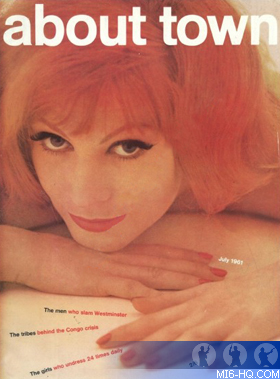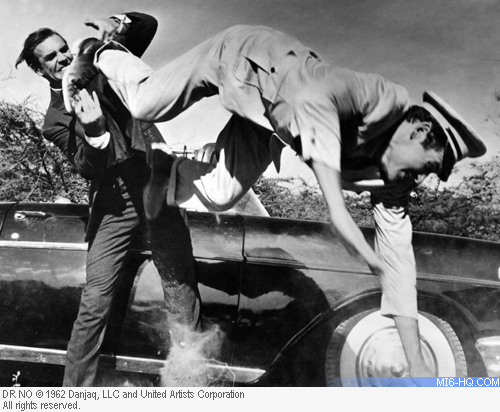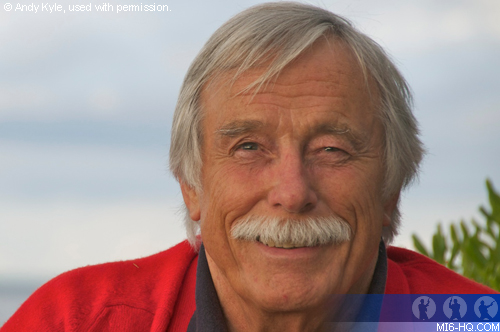The Original Model Bond
5th April 2013
Guest writer Edward Biddulph investigates the case of Peter Anthony, one of the few men to screen test for Bond back in 1961
The months before Daniel Craig was offered the role of James Bond in October 2005 saw intense media speculation about who would succeed Pierce Brosnan. Little had changed since 1961 when the producers Harry Saltzman and Cubby Broccoli announced that they were about to film the first James Bond film, "Dr. No". Before Sean Connery had been cast, there was much anticipation in the press even at this early stage in the film series.
One of the journalists who joined the speculation, and indeed cultivated much of it, was Patricia Lewis, the show-business editor of the Daily Express. In an article published in June 1961, Lewis reported that the producers of "Dr No" were have trouble casting James Bond, although she revealed that Harry Saltzman was planning to screen-test Patrick Allen, and was "also thinking about Michael Craig and Patrick McGoohan". Nothing came of these tests, and so on July 20th Patricia Lewis launched a competition in the Express to find the perfect Bond actor. In an article entitled, 'In search of a he-man', she invited "every tough-talking type" to have "a crack at landing this plum role". Lewis added that proof of acting ability was also required. Applicants were invited to submit their acting résumés and vital statistics to Lowndes Film Productions in Soho Square, London. Six finalists were to invited to a judging panel, which Lewis boasted would comprise of Harry Saltzman, Cubby Broccoli, Ian Fleming, and Ken Hughes, as well as Lewis herself. The winner would be announced as James Bond and be rewarded with a three-year contract to star in two Bond films a year. |
|
One of the finalists was Peter Anthony, a professional model from London. His career had developed with Man About Town, a lifestyle magazine published during the 1950s and '60s for men, covering sport, drink, food, cars, and clothes, especially suits. One of its photographers was Terence Donovan, a pioneer of the 'blow-up' school of photography, who brought a sophisticated, masculine, film-style look to the magazine. His shots were about action and story. Set in real places far removed from the artificial creation of the studio, the photographs had a narrative drive that turned fashion shoots into stills from a film-noir or spy thriller. Peter Anthony was one of Donovan's stars.
|
In one image from 1960, 'Starting Over', Peter Anthony is behind the wheel of a sports car. He is focused on the road ahead and drives with confidence. Another photograph, from 1961, shows Anthony in the foreground. He wears a sharp suit and a shoulder holster for an automatic. Adding to the suspense is the man in the shadows, who hides behind a copy of the French newspaper, Le Figaro. And the title of this intriguing scene? 'The secrets of an agent.' The image could be lifted from Fleming; the hero could be Bond. Peter Anthony sent these images to Broccoli and Saltzman. The producers were impressed and proclaimed that he was an "exciting find", and in due course Anthony received an invitation to a screen-test. He was also sent a two-page audition script. The scene which Anthony performed was taken from an early draft of the "Dr. No" screenplay. Set in M's office, the scene in the released film shows Bond being ordered by M to discard the Beretta in favour of the Walther PPK after hearing the expert opinion of the armourer. In the audition script, Anthony's dialogue was a little different. |
Bond enters M's office and is still quizzed about his last assignment in which his Beretta jammed, but M simply tells Bond that the gun has to be replaced. Bond reluctantly agrees. "I'm just sorry to see it go," says Bond. There is no armourer and no mention of the Walther PPK.
On September 21st, Patricia Lewis announced in the Daily Express that Peter Anthony had won the competition, which took place at Twickenham Studios. She quoted Broccoli as saying that Anthony had "a Greg Peck quality that's instantly arresting". This is not difficult to see from the image that Anthony had exploited during his earlier modelling career. Anthony looked great in a suit, and sophisticated with just the right hint of menace to have the edge over his enemies and the hold on the women. But image was not everything. The producers agreed that he had potential, but was too risky to try out in their first film.
What of the other five finalists? According to Lewis' article in September 1961, the finalists were Gordon Cooper, a sales rep from Warrington, Anthony Clements, another salesman, this time from Bolton, Frank Ellement, a former teacher turned actor from London, Michael Ricketts, an aerial ropeways engineer from Hadleigh in Essex, and Bob Simmons, a stuntman who would unofficially become the first Bond of the Eon series as the figure seen in the gun barrel sequence of "Dr. No".
|
But Peter Anthony's brush with the world of James Bond did not end with "Dr. No" casting. In fact he auditioned for the role of Bond again, this time for "Diamonds Are Forever". With the Daily Express having no involvement, Eon Productions approached Anthony and sent him once again two pages of the script. At the time, Anthony was living in New York and was required to fly to Los Angeles for the screen-test. He remembers that he performed his test in the morning and was later taken to meet Broccoli and Saltzman and, he thinks, Guy Hamilton.
Peter Anthony performed the scene in which Bond introduces himself as Peter Franks to Tiffany Case. The script he received again differed from the scene in the final film. There was, for example, extra dialogue. In the script, Bond asks Tiffany whether he can smoke, and a few lines later is asked to guess what the 'T' in T Case shown on the doorbell stands for. "Teresa. Tamara. Tepa. Tammy. Tallulah?", Bond asks. Some lines that were retained in some form in the final film had changed between the audition and final shooting scripts. Tiffany's memorable line in the film, "My god! You killed James Bond!", was originally the slightly less succinct, "Not THE James Bond. The famous 007." The sequence is also conflated with the later scene in which the real Peter Franks arrives at Tiffany's apartment. Franks knocks on the door of the apartment and is then killed by Bond after a fight. The vicious fight in the lift is absent.
Whether the scripts for both films were especially adapted for the screen-tests, or that they were subsequently rewritten is uncertain, but both give us insights into the nature of screen-tests in the early days of the Bond films. Peter Anthony's auditions for the role of James Bond provide a fascinating footnote in the history of the Bond films. Though Anthony never won the role, he had clearly impressed Broccoli and Saltzman. Peter Anthony really could have been a model Bond.
|
We are grateful to Peter Anthony and Andy Kyle for helping the author with his research, and providing such invaluable information.











